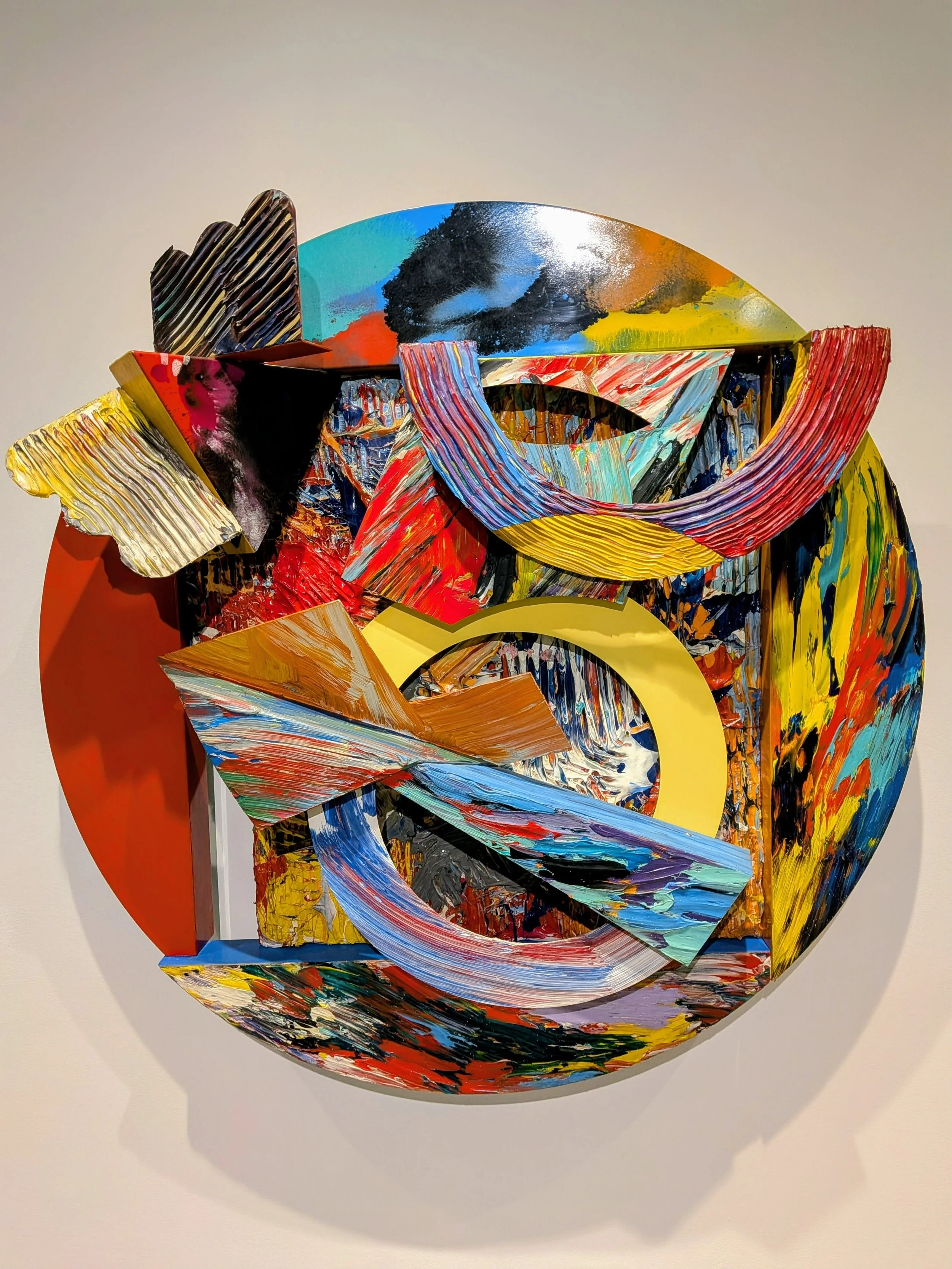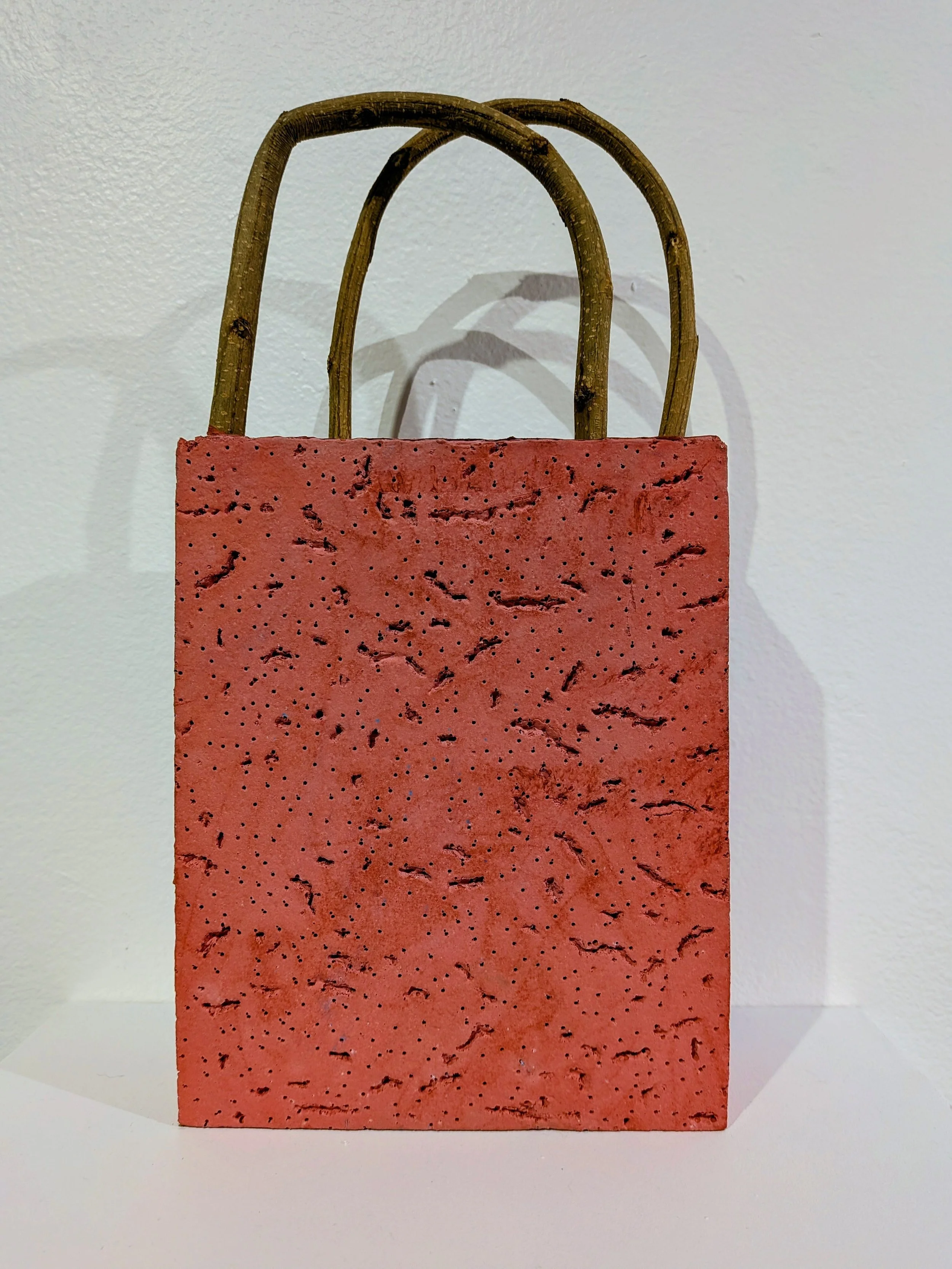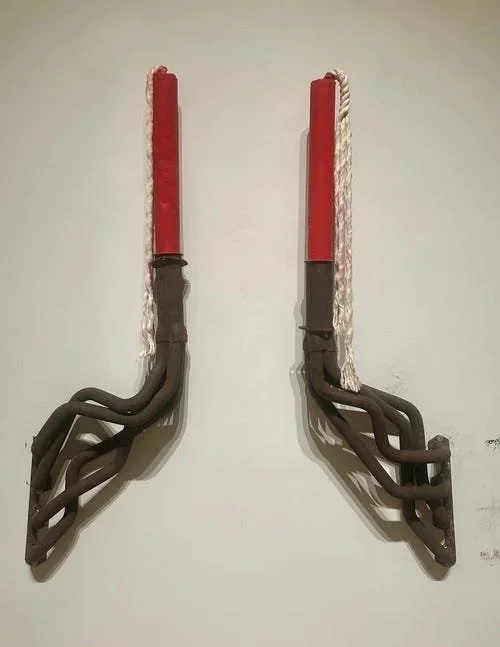“African Americana
Before the Americas” is a powerful overview of Black, Latino, and Afro-Latino experience. Also: Chernow, Curren, West, & Levine at Studio; “Painting Interrupted” at Otis St.; Feuer at Transformer
MARK JENKINS
Nov 11
Sam Gilliam, “Ain’t More Than Music” (photo by Mark Jenkins)
IF “BEFORE THE AMERICAS” LOOKS LIKE A MUSEUM-QUALITY SHOW, that might be because it was planned for the Organization of American States’s Art Museum of the Americas. Developed over several years by the venue and its curator, local artist Cheryl D. Edwards, the exhibition was cancelled this spring after the Trump administration began its anti-diversity offensive. The 39-artist show was moved to George Mason University’s Gillespie Gallery of Art, which it fills spectacularly with work by Black, Latino, and Afro-Latino artists.
The show illustrates four themes: ancestral memory, migration, invisibility, and interconnectivity. But the art can be seen essentially as personal, historical, or some mingling of the two. The centerpiece is Sam Gilliam’s “Ain’t More Than Music,” an abstract 1989 sculptural painting that revels in its bold colors and forms while invoking the sustaining power of music for Africa-rooted communities. Yet there are also pieces that explicitly depict those communities’s histories of oppression and exploitation. A fine example of the latter is Manuel Mendive’s “Barco Negrero,” a silkscreen of a slave ship that’s heavily stylized but no less harrowing for its simplification.
Mendive is Cuban, and one of more than a dozen Caribbean contributors to the show. The majority of the artists, however, are or were Washingtonians. These include such recently departed artists, in addition to Gilliam, as Alonzo Davis, John Beadle, Samella Lewis, Lou Stovall, and Nelson Stevens. As might be expected, there are works by Alma Thomas -- her usual format, but with an unusually muted palette -- and Elizabeth Catlett. The latter, a D.C. native who became a Mexican citizen, used traditional techniques to portray people, often Black women, who traditionally had not been represented.
As depicted here, personal identity is both complex and elementary. Renée Stout dangles an assemblage of talismanic found objects, including a bell and mysterious blue bottle, and titles it “Self-Portrait.” Martin Puryear, a D.C.-rooted Chicagoan, reduces the self-portrait to a single hand, rendered in his usual wood. African sculptures, dancers, and masks represent both cultural pride and a sense of loss in works by Beadle, Lois Mailou Jones, and E.J. Montgomery.
Davis reconstructs his heritage from lengths of bamboo, arranged to suggest both rafts and African folk instruments. Ethiopia-born Washingtonian Alexander “Skunder” Boghossian depicts his legacy as a sort of dark carpet of memories, punctuated by crosses. Among the most striking works is “Unmasked,” by Wilfredo Valladares, a Honduras-born D.C. area resident. His sculpture is a cast-iron oblong of several relief faces, stacked vertically, that sits on a deck of rough wooden slats. It speaks to both humanity and myth.
Several of the pieces in the show are from the OAS collection, and the Thomas canvas belongs to American University. The Gilliam artwork was recently donated to George Mason, which plans to place it in a campus museum once it’s established. Perhaps by the time that happens, the U.S. will again have a president who accepts that the first amendment guarantees freedom of expression.
Chris Chernow, “Quietude” (Studio Gallery)
HUSHED PICTURES BY CHRIS CHERNOW SET THE TONE for most, but not all, of the exhibitions now at Studio Gallery. The local artist’s “Stillness in the Noise” is a series of soft renderings of women -- sometimes nude, usually alone, and in a serene mood. Similarly tranquil are Cristy West’s mixed-media abstractions, Jo Levine’s closeup nature photos, and a few elegant, earth-toned ceramics by Lisa Battle. Elizabeth Curren disrupts the consensus, however, with topical commentaries made of cut paper and lots of words.
Chernow’s show, curated by Adah Rose Bitterbaum, is divided between paintings and drawings. The former are gauzy oils while the latter employ some mix of charcoal, pencil, acrylic ink, watercolor, and water-soluble graphite. The two series are equally deft and entirely compatible, linked by subject matter as well as style. The effect of the thinned oil paint is quite similar to that of the streaky pigments that turn the drawings into almost-paintings. Both varieties are also linked by a similar palette, heavy on brown, grayish green, and peachy flesh tones.
The women in these pictures are solitary, save for three groupings of three each, two sets of which depict poses that suggest dancing. Aside from one picture with a near-black backdrop, the subjects and their surroundings are so similarly hued that boundaries between them blur. These women are alone, but not alienated. Indeed, Chernow’s color schemes suggest that fitting into your environment is essential to finding moments of peace.
Downstairs at Studio, West is exhibiting layered abstractions that combine painting, drawing, and collage. Often made with a meld of oil paint and cold wax, the pictures -- curated by Gaby Mizes -- suggest weathered walls and buildings and geological strata, and sometimes recall Cianne Fragione’s style. The local artist’s eclectic technique also has a calligraphic element, evoking brazen graffiti and delicate palimpsests. West’s strategy is intuitive, but it hints at multifold historical tiers beneath the heavily worked surfaces.
Nearby is Levine’s “Garden of Wonders,” a selection of crisp, vivid photos made at the U.S. Botanical Garden and curated by Iza Thomas and Robert Cwiok. One picture depicts a single vine curved on a marble wall, locating the sprig of greenery in ceremonial Washington. But the other photos peer so closely at their subjects that they lose their context, and sometimes even their identity as flora. The local artist has given a few of these images titles such as “Medusas” and “Tentacles,” highlighting the similarity of leaves and fronds to aquatic creatures. Viewed this intimately, botanical wonders can look like anything and everything.
Between West and Levine’s shows is the stark contrast of Curren’s “Red/White/Blue,” a current-events primer rendered in what the local artist calls the “weaponized colors” of the U.S. flag and election-night results maps. The silhouetted stars of this selection, which was curated by Judy Southerland, are a regretful Joe Biden and an oblivious Donald Trump. The former and current president are not accorded equal respect, but then how could they be? A smiling Biden muses while a demonic Trump blathers, prattling words and phrases that one title characterizes as “Barf.” Most effective is an artist’s book whose dozens of red tags list terms banned or limited by Trump administration edicts. As the Trump cabal pushes euphemisms, circumlocutions, and outright lies, Curren cuts to reality.
Sean Sweeney, “BYOB” (photo by Mark Jenkins)
AT THE ENTRANCE OF OTIS ARTS PROJECT’S “PAINTING INTERRUPTED” is a white plastic chair, tipped over on a square of turf. This tableaux is fixed in place, yet its individual elements could be altered or disturbed. Thus the installation is unlike the small painting of the same scene mounted on a nearby wall, whose parts can’t be moved, or the video of the chair, in which a hand trims the grass, a basic gesture that loops perpetually. Artist Kate Fleming, an Arlingtonian, uses a simple setup to illustrate different states of being and motion.
Fleming’s triple-media embodiment of the same scenario is the conceptual centerpiece of the four-artist show, which was curated by Stephanie Cobb. Fleming’s concerns are similar to those of Marisa Stratton, who paints small portraits derived from photographic Internet images. The D.C. artist’s style is realistic but loose, and her pictures in this selection have a further impetus toward impressionism: They’re painted on wooden cylinders that can rotate so the faces blur as they move. When in action, the paintings are not so much interrupted as spun into infinity.
The other two contributors are sculptors, although one of them does employ paint. D.C. artist Mary Ratcliff offers small bronzes whose cast tendrils seem to be derived from vines and stalks, but which turn decorative when they meld into the pieces’s attached frames. Sean Sweeney uses concrete, supplemented by wood or wire, to simulate paper. His “BYOB” assumes the shape of a shopping bag, yet it’s made of red-painted concrete and its handles are burly sticks. The cracked surface of the simulated bag adds to a sense of impermanence, but these sleek sacks are clearly a lot more durable than paper. Sweeney, who’s based in Baltimore but has a Washington museum job, subverts familiar forms with incongruous materials, interrupting not painting but expectation.
Mia Feuer, “Exhaust (Shabbat Candles)” (Transformer)
THERE’S A LOT OF AUTOBIOGRAPHY IN MIA FEUER’S Transformer show, and if that’s not immediately obvious, the obstacle might be that the Canadian artist’s roots are intriguingly tangled. Hockey is a big part of the story, although Feuer is perhaps not the typical north-of-the-border sportswoman. The artist’s notes to “A Tender Sieve” identify her as a member of “a working class Ashkenazi family” raised on “Cree, Ojibwe, and Métis land, colonially known as Winnipeg, Manitoba.” Also, she was and is a hockey goalie, now in Oakland, near where she teaches sculpture at the California College of the Arts. In hockey lore, a “sieve” is a derogatory term for a goalie who lets the puck through.
Feuer has filled Transformer’s small space with hanging assemblages made of hockey goalie pads. The forms of these objects immediately evoke chrysalises, about to yield butterflies. This seemed the proper interpretation even before it was attested by the series title, “Learning to Butterfly.” Alternately, the suspended objects could be seen as animal carcasses, a resemblance suggested not only by their bulk but also by their gristly patterns. So the cut-together synthetic materials evoke organic phenomena, whether ephemeral or meaty.
Two wall-mounted entries play, at least partially, on Feuer’s religious heritage. “My Dad’s 10 Commandments of Goaltending,” rendered in metallic watercolor and ink, takes the popularly accepted shape of the tablets supposedly given to Moses on Mount Sinai. Equally playful is a large pair of Shabbat candles made of red wax and mounted on candlesticks fashioned from rusted exhaust intake-manifold pipes from a car or truck. Like a caterpillar, but knowingly rather than instinctively, Feuer seeks transfiguration.
Before the Americas
Through Nov. 15 at Gillespie Gallery of Art, George Mason University, 4400 University Dr., Fairfax. www.masonexhibitions.org
Chris Chernow: Stillness in the Noise
Cristy West: In the Moment
Jo Levine: Garden of Wonders
Elizabeth Curren: Red/White/Blue
Through Nov. 22 at Studio Gallery, 2108 R St. NW. studiogallerydc.com. 202-232-8734
Painting Interrupted
Through Nov. 15 at Otis Street Art Project, 3706 Otis St., Mount Rainier. otisstreetarts.org.
Mia Feuer: A Tender Sieve
Through Nov. 21 at Transformer, 1404 P St. NW. transformerdc.org. 202-483-1102.”
Written by Mark Jenkins in DisCerning Eye, thank you!





